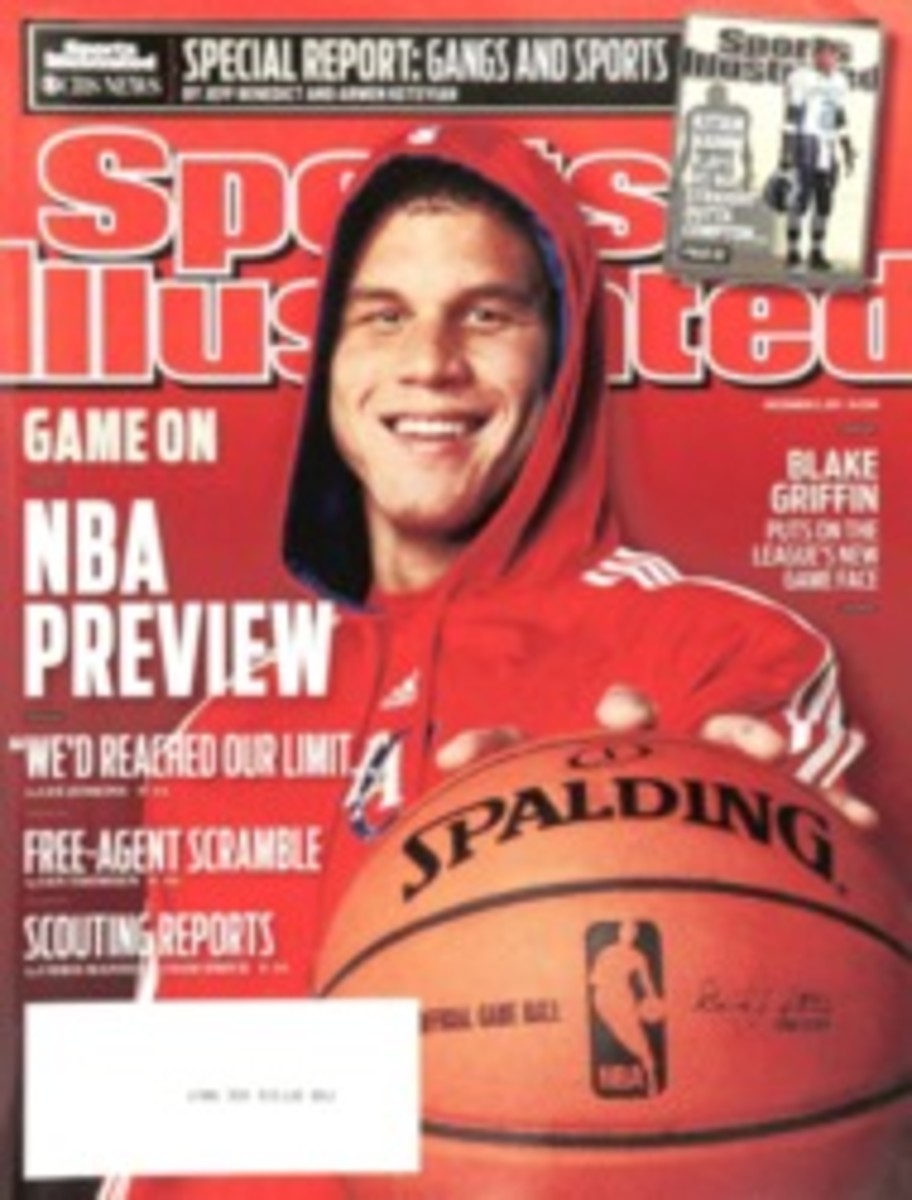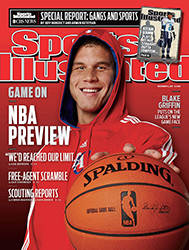
TREY MAGNIFIQUE
For 13 years Robert Nyakundi's favorite three-pointer was the buzzer beater Valparaiso guard Bryce Drew nailed to upset No. 4 seed Ole Miss in the first round of the 1998 NCAA tournament. "That's one of the greatest of all time," says the SMU senior, who was a nine-year-old living in Arlington, Texas, when Drew hit the Shot. Playing in the driveway or in the park thereafter, Nyakundi says, "I tried to put myself in that moment—3, 2, 1, game-winner! I always wondered, How amazing would that be, to hit one for your school?" Last Jan. 26 he found out. With 1.1 seconds left and host Tulsa up 58--56, Nyakundi launched a three from the left corner that snapped through the net and broke a 10-game losing streak against the Golden Hurricanes. "It was a great feeling," he says. "And, yes, that's now my favorite three."
What college player doesn't share Nyakundi's fantasy of making a heroic, game-saving trey? If Division I coaches had had their way a quarter century ago, none would. When NCAA rules chair Ed Steitz instituted the three-point shot before the 1986--87 season, a chorus of coaches cried foul (65% were against the new rule, according to a rules-committee poll). "Ridiculous," declared Iowa State coach Johnny Orr at the time. "A farce," cried commentator Dick Vitale. "Next thing you know," carped USC coach George Raveling, "we'll have trained seals out there." SI was not a fan either, denouncing the "win-a-teddy-bear-at-the-carnival length" (then 19'9") and predicting that the game would devolve into "five stationary wimps unloading from the half-moon line, followed by their opposing number doing the same thing at the other end."
The Cassandras had it wrong, of course. Rather than being the agent of the game's ruination, the three has been the best thing to happen to it since Dr. Naismith decided to cut out the bottoms of the peach baskets. The trey is not only the game's great equalizer—"basketball's spread option," as Wisconsin associate head coach Greg Gard puts it—but it has also superseded the dunk as the game's home run, just as Steitz predicted it would. Moreover, the three has allowed for more action all over the court because defenses have to be extended. "If it wasn't for the three-point line, you wouldn't see all these great dunks and all these backdoor cuts," says Louisville coach Rick Pitino.
Nor would you see comebacks like the one Pitino's 1993--94 Kentucky squad pulled off at LSU, when the Wildcats, down 31 with 15:34 to go, hit 11 three-pointers on the way to beating the Tigers 99--95. Or the one executed by Presbyterian at No. 20 ranked Cincinnati on Nov. 19, in which the Blue Hose's Khalid Mutakabbir hit two threes in the last 1:17, including the game-winner with 7.6 seconds left, to help overcome a 15-point second-half deficit and shock the Bearcats 56--54.
And without the arc, Cinderella wouldn't have nearly as much fun at the ball. Pitino knows all about that too. Twenty-five years ago he was in his second year at Providence, a program that had been stuck near the Big East's cellar since the league's inception in 1979. "We had a very average-to-below-average basketball team [in 1986--87]," says Pitino, "so I was looking for a gimmick."
After playing an exhibition that season against a Soviet team that launched 28 threes, Pitino realized how his team could best use the new rule to its advantage; the Friars, he determined, would hoist 25 threes a game to supplement a relentless full-court press. That strategy, not to mention the 40.9% perimeter execution of 6-foot point guard Billy Donovan, took the Friars all the way to the Final Four.
Yet it was one of the shot's biggest detractors, Indiana's Bob Knight—he had compared Steitz to the inventor of the Edsel—who benefited most from the three that first year, even more so than Pitino's Friars. In 1986--87 the Hoosiers led the country in three-point percentage (50.8%) and won the NCAA championship behind the lethal perimeter shooting of 6'2" senior guard Steve Alford, whose seven makes from behind the arc in the 74--73 win over Syracuse is still the most in title-game history. "At least for that one year I think [Knight] liked the three," says Alford, now the coach at New Mexico.
No Division I team has shot better than 50% from three-point range since that first season. Nationally, teams have gone from shooting 9.2 per game and making 38.4% in 1986--87 to attempting 18.2 and making 34.3% in 2010--11. (Extending the line an additional foot for the 2008--09 season had no significant statistical impact.) The drop in accuracy is the result of better scouting, weaker shooters launching more often and, most important, evolving defensive priorities.
"You have to be able to take away the three," says Memphis coach Josh Pastner, who would like to see the line extended to the NBA distance of 23'9". "Because of that shot, you're never out of a game and no lead is ever safe. Simply put, the three is the difference between winning and losing."
The three is now so glorified that every player wants to shoot it, even guys who can execute that other highlight staple, the dunk. Nyakundi, whose 49.7% shooting from behind the arc was second in the country last season, is a 6'8" forward who leads his team in rebounds this season (5.3 per game). He likes dunking fine, he says, "but the three-pointer takes a lot more concentration because there's more pressure. It's always a gut check."
In other words, it's not a shot for wimps.
"NEXT THING YOU KNOW, WE'LL HAVE TRAINED SEALS OUT THERE," SAID USC COACH GEORGE RAVELING DURING THE THREE-POINT LINE'S DEBUT SEASON.
"SIMPLY PUT, THE THREE IS THE DIFFERENCE BETWEEN WINNING AND LOSING," SAYS MEMPHIS COACH JOSH PASTNER OF THE SHOT'S IMPORTANCE TO THE GAME NOW.
"IF IT WASN'T FOR THE THREE, YOU WOULDN'T SEE ALL THESE GREAT DUNKS AND BACKDOOR CUTS," SAYS RICK PITINO.
1986--87
BILLY DONOVAN
Playing for a coach (Pitino) who embraced the game's new "gimmick," Billy the Kid took full advantage, hitting 97 of 237 treys and leading once lowly Providence to the Final Four.
1987
STEVE ALFORD
The Indiana guard's 7-for-10 performance from beyond the arc in the NCAA championship game against Syracuse set the stage for Keith Smart's title-clinching jumper.
1987--88
STEVE KERR
During his senior year the Arizona guard set a single-season NCAA record by hitting a three in 38 consecutive games, a mark he still holds. Kerr made 57.3% of his threes that year.
1994
CHARLOTTE SMITH
One of only two UNC women's basketball players to have her jersey retired, Smith's buzzer-beating trey gave North Carolina a 60--59 win over Louisiana Tech in the national title game.
1998
BRYCE DREW
The play was called Pacer, and it was run to perfection. The Valparaiso guard nailed a three from the right wing as time expired to stun No. 4 seed Ole Miss in the first round of the NCAA tournament.
2006
J.J. REDICK
On Feb. 14, the Duke senior guard hit number 414 to become the NCAA's alltime leader in three-pointers, breaking the mark held by Virginia's Curtis Staples. Redick would finish with 457.
2008
MARIO CHALMERS
On the 20th anniversary of the Jayhawks' last NCAA championship, Mario's Miracle with 2.1 seconds left sent the title game against Memphis into overtime, which ended with Kansas winning.
2010
ALI FAROKHMANESH
With No. 9 seed Northern Iowa clinging to a one-point lead over top-seeded Kansas in the second round, the 6-foot senior guard swished a three with 42.8 seconds left that effectively ended the Jayhawks' dreams of the title.
BIG SHOTS
Having an elite three-point shooter can spell the difference between making the Big Dance and a madness-free March. Here are the top six players to watch from behind the arc this season
ROBERT NYAKUNDI
SMU
48.5%
The top returning three-point shooter in the nation (49.7% in 2010--11), the senior forward has improved his overall field goal percentage to 52.5 (from 48.1 last season).
DORON LAMB
Kentucky
46.2%
Even on the most stacked team in the country, Lamb stands out: Through six games he leads the Wildcats in scoring (14.2 ppg) and perimeter shooting (hitting 12 of 26 treys).
MARCUS DENMON
Missouri
44.4%
One of the nation's most efficient players, the senior guard's shooting skills have earned him a reputation as a "no-catch" guy: Opponents try to prevent him from touching the ball.
ASHTON GIBBS
Pitt
45.0%
After earning the nickname Microwave as a freshman for his frequent and timely three-pointers, the senior guard now leads the Panthers in scoring (19.0 ppg).
MALCOLM GRANT
Miami
40.4%
The senior guard led the ACC last season in threes made (94), and the Canes' leading scorer (17.8 ppg) is again the best in the league with 19 made threes through five games.
SETH CURRY
Duke
57.1%
Like his dad, Dell, and older brother, Stephen (who set the NCAA single-season mark of 162 with Davidson in '08), the junior guard is an ace from behind the arc. His 15.1 ppg leads Duke.
THREE-POINT PERCENTAGES ARE FROM THE 2011--12 SEASON.
NATIONAL AVERAGE: 33.3%
PHOTO
BILL LUSTER (DONOVAN)
PHOTO
JERRY WACHTER (ALFORD)
PHOTO
RICH CLARKSON/RICH CLARKSON & ASSOC. (KERR)
PHOTO
JIM GUND/GETTY IMAGES (SMITH)
PHOTO
DAVID E. KLUTHO (DREW)
PHOTO
ELLEN OZIER/REUTERS (REDICK)
PHOTO
JOHN BIEVER (CHALMERS)
PHOTO
GREG NELSON (FAROKHMANESH)
PHOTO
AL TIELEMANS (COURT)
PHOTO
BACKGROUND BY SI IMAGING
PHOTO
MATTHEW VISINSKY/ICON SMI (NYAKUNDI)
PHOTO
BOB ROSATO (LAMB)
PHOTO
BOB ROSATO (CURRY)
PHOTO
PETER G. AIKEN/KANSAS STATE/GETTY IMAGES (DENMON)
PHOTO
FRED VUICH (GIBBS)
PHOTO
JAKE DRAKE/CAL SPORT MEDIA (GRANT)

